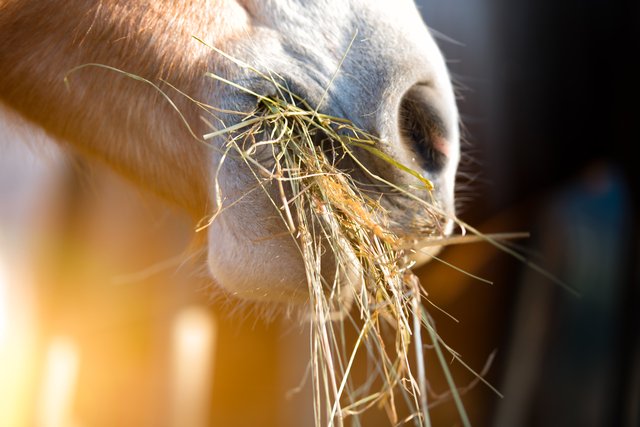Just like humans rely on fruits and vegetables for nutrition, horses depend on grass as a crucial part of their diet.
Understanding the role of grass in a horse’s diet is imperative for the well-being and health of these magnificent animals.
In this guide, we will explore why grass is so important for horses, the benefits it offers, and how you can ensure your horse is getting the right amount of this staple food.
Types of Grass Suitable for Horses
A crucial aspect of a horse’s diet is the type of grass they consume. Different varieties of grass offer various nutritional benefits and suit different climatic conditions.
Understanding the types of grass suitable for horses can help ensure their health and well-being.
Cool-Season Grasses
Grasses such as Kentucky bluegrass, orchard grass, and timothy are categorized as cool-season grasses.
These grasses thrive in cooler temperatures and provide excellent nutrition for horses during the spring and fall months.
Warm-Season Grasses
Some warm-season grasses that are suitable for horses include Bermuda grass, zoysia grass, and bahiagrass. These grasses grow best in warmer climates and offer a rich source of nutrients for horses.
Cool-season grasses, on the other hand, tend to lose their nutritional value and can become less palatable to horses during the hot summer months.
Tropical Grasses
While not as commonly found in temperate regions, tropical grasses such as Panicum and Setaria can also be suitable for horses.
These are well-adapted to hot and humid climates and provide a lush source of nutrients for horses.
Native Grasses
On some horse farms, native grasses like fescue and ryegrass are prevalent. These grasses are adapted to local conditions and can provide a natural and sustainable source of forage for horses.
Plus, they require less maintenance compared to other grass varieties.
Factors to Consider When Feeding Horses Grass

It is important to consider several factors when feeding horses grass to ensure their health and well-being.
These factors include nutritional value, palatability and digestibility, availability and accessibility, and quality and contamination risks.
Nutritional Value
Assuming that the grass is of good quality, it can provide horses with important nutrients such as carbohydrates, protein, vitamins, and minerals. However, the nutritional content of grass can vary depending on the type of grass and its maturity.
Palatability and Digestibility
Feeding horses grass that is palatable and easily digestible is important to ensure that they are willing to eat and able to extract nutrients effectively.
Horses may refuse to eat certain types of grass or hay if they find it unpalatable.
Availability and Accessibility
Grass should be readily available to horses for grazing or feeding to meet their nutritional needs.
Access to fresh grass can help prevent boredom and provide enrichment for the horses, especially if they are kept in a dry lot or stall for most of the day.
Quality and Contamination Risks
Even though grass is a natural and healthy option for horses, there are risks associated with the quality and potential contamination of the grass.
It is essential to monitor the quality of the grass to prevent issues such as mold, pesticides, or other contaminants that could harm the horses.
Palatability plays a large role in the acceptance of grass by horses. Ensuring that the grass is free from molds, toxins, or harmful substances will help maintain its palatability, making it a safe and enjoyable food source for horses.
Tips for Ensuring a Balanced Diet with Grass
Unlike processed feeds, grass provides a natural and balanced diet for horses. However, it is imperative to ensure that your equine companion is receiving all the necessary nutrients for optimal health.
- Ensuring Adequate Space for Grazing
- Rotating Pastures for Optimal Nutrition
- Monitoring Grass Quality and Quantity
- Supplementing with Hay or Grains as Needed
Providing Adequate Space for Grazing
Ensuring your horse has enough space to graze is crucial for maintaining a balanced diet with grass. Horses need ample room to roam and access fresh grass to meet their dietary requirements.
Rotating Pastures for Optimal Nutrition
There’s a significant benefit in rotating pastures to ensure your horse receives a variety of grass types with different nutritional profiles. This practice helps prevent overgrazing and allows the grass to regrow efficiently.
Monitoring Grass Quality and Quantity
Assuming your horse has access to good-quality grass is not enough. Regularly check the pasture for any signs of overgrazing or nutrient deficiencies, and adjust your horse’s diet as needed to maintain a healthy balance.
Supplementing with Hay or Grains as Needed
Nutrition is key when it comes to supplementing your horse’s diet with hay or grains. Depending on the grass quality and your horse’s individual needs, additional supplementation may be necessary to ensure a well-rounded diet.
Step-by-Step Guide to Introducing Horses to New Grass
After understanding the importance of a gradual transition to new grass in a horse’s diet, it’s important to follow a step-by-step guide to ensure a smooth introduction process.
This guide will help horse owners make informed decisions and monitor their horse’s health throughout the transition.
| Assessing the Horse’s Current Diet and Health | Gradually Introducing New Grass Sources |
Assessing the Horse’s Current Diet and Health
Little changes can have a big impact on a horse’s health. Before introducing new grass, assess the horse’s current diet and overall health to determine if they are ready for the transition.
Gradually Introducing New Grass Sources
Diet plays a crucial role in a horse’s well-being. When introducing new grass sources, it’s important to do so gradually. Start by mixing small amounts of new grass with their current feed and slowly increase the proportion over several days.
Understanding the horse’s digestive system and nutritional needs is key to a successful introduction process. Different grass types may have varying levels of nutrients and fiber, so introducing them slowly allows the horse’s gut to adapt to the changes.
Monitoring for Signs of Discomfort or Illness
While introducing new grass, it’s crucial to monitor the horse for any signs of discomfort or illness. Changes in behavior, such as reluctance to eat or abnormal stool, can indicate that the new grass is causing problems for the horse.
Horses have sensitive digestive systems, and sudden dietary changes can lead to issues like colic or laminitis. By closely monitoring the horse’s health and behavior, owners can address any concerns promptly and adjust the introduction process as needed.
Adjusting the Introduction Process as Needed
For a successful transition to new grass, flexibility is key. If the horse shows signs of discomfort or digestive issues, it’s important to adjust the introduction process accordingly. This may involve slowing down the transition or reverting to their previous diet temporarily.
Discomfort or illness should never be ignored, and seeking veterinary advice is crucial if the horse’s health is at risk. By being attentive to the horse’s reactions and making necessary adjustments, owners can ensure a safe and effective introduction to new grass in their diet.
Pros and Cons of Feeding Horses Grass

| Benefits | Potential Drawbacks |
| Rich in vital nutrients | Possible risk of obesity |
| Natural source of fiber | Overconsumption leading to digestive issues |
| Helps prevent boredom | Potential exposure to toxic plants |
Benefits of Grass in Equine Diets
The consumption of grass provides horses with vital nutrients, including vitamins and minerals, that are necessary for their overall health and well-being.
Potential Drawbacks and Risks
An overabundance of grass can lead to obesity in horses, as it is high in sugars and calories. Additionally, there is a risk of digestive issues if horses overconsume grass.
For instance, some pastures may contain toxic plants that can be harmful to horses if ingested. It is important for horse owners to carefully monitor their horses’ grazing areas to prevent exposure to such plants.
Balancing the Advantages and Disadvantages
Equine diets should be carefully balanced to incorporate the benefits of grass while mitigating the potential drawbacks. This can be achieved through proper pasture management and supplementation if needed.
Diets should be tailored to each individual horse’s nutritional needs to ensure they receive the necessary nutrients without the associated risks of overconsumption or exposure to toxins.
Common Mistakes to Avoid When Feeding Horses Grass

Depleting pasture resources by overgrazing can lead to a lack of nutritious grass for horses. It is important to rotate pastures to allow grass time to regrow and prevent depletion of vital nutrients in the soil.
Failing to Monitor Grass Quality and Quantity
While it may seem that horses can simply graze freely, it is crucial to monitor the quality and quantity of grass they consume.
Horses need a balanced diet, and ensuring they have access to varied grasses can help prevent nutrient deficiencies.
The amount of grass available to horses should be monitored to prevent overeating, which can lead to obesity and other health issues.
It’s essential to manage grazing areas to ensure that horses have a consistent and appropriate amount of grass to eat.
Neglecting to Provide Adequate Water and Shelter
Neglecting to provide horses with access to clean water and shelter can have serious consequences on their health.
Horses must have constant access to fresh water and a sheltered area to protect them from extreme weather conditions.
The well-being of horses is directly linked to their diet and living conditions. By avoiding these common mistakes and ensuring horses have a balanced diet, access to fresh water, and adequate shelter, you can help keep your equine companions healthy and thriving.
Conclusion
As a reminder, understanding the importance of grass in a horse’s diet is crucial for their overall health and well-being. Grass provides crucial nutrients, fiber, and hydration, making it a staple in equine nutrition.
By monitoring a horse’s grass intake and ensuring they have access to quality grazing, owners can help maintain their horse’s health and vitality.
